| dc.description.abstract | The use of social media platforms such as Facebook or Twitter increased exponentially over the last years. They have become a major tool for people to communicate, and for news media to relay their content. In parallel with this growth, researchers have started to use social media in various domains of study, including the analysis of people’s behavior on these online platforms during natural disasters. Diverse aspects of this behavior have been studied in the literature, including the detection of a disaster, the variations of the sentiment expressed, the differences regarding the distance to a disaster, or even the improvements of relevant content labeling. To the best of our knowledge, no study has been conducted that considers Twitter as a sensor with different sensitivity levels to different types of natural disasters, which brought us to analyze Twitter as a social sensor during different types of these events.
The data used in this study is streamed from the Twitter Public Stream and tweets have been pre-processed to keep those in English, with geo-coordinates and from the contiguous United States only; the text content has also been cleaned and tweets have been filtered using a list of general keywords that we built. We select 5 natural disasters of different types that occurred over the recent years, and for each of them we detect the shifts in behavior of the Twitter data in order to compare and contrast before, during and after the disaster the variations of tweet frequency, the proximity to the center of the disaster, the variations of sentiment expressed and the variations of tweet frequency by level of social vulnerability.
The results obtained in the empirical analysis demonstrate that Twitter is indeed a social sensor with different sensitivity levels to natural disasters. As a matter of fact we observe, depending on the type of disaster, different patterns of tweet frequency and proximity-to-disaster; negative sentiment tweets also tend to cluster closer to the disaster during the disrupted period, and finally areas with high level of social vulnerability are generally more sensitive compared to the others. The lack of available data can sometimes be an issue, but this work is an important finding to define Twitter as a social sensor to natural disasters. | en_US |
